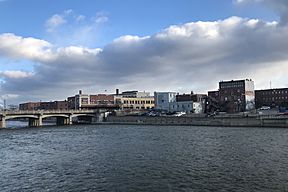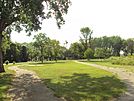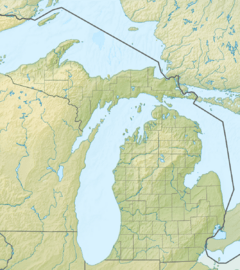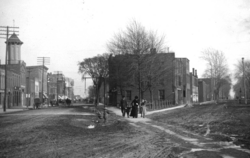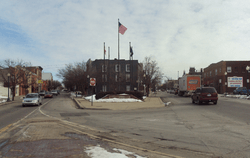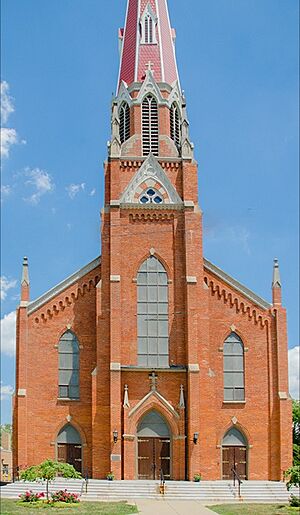Monroe, Michigan facts for kids
Quick facts for kids
Monroe, Michigan
|
||
|---|---|---|
|
Downtown Monroe along the River Raisin
Monroe County Courthouse
|
||
|
||
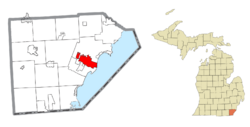
Location within Monroe County and the state of Michigan
|
||
| Country | United States | |
| State | Michigan | |
| County | Monroe | |
| Settled | 1785 | |
| Platted | 1817 | |
| Incorporated | 1837 | |
| Government | ||
| • Type | Council–manager | |
| Area | ||
| • City | 10.21 sq mi (26.46 km2) | |
| • Land | 9.05 sq mi (23.43 km2) | |
| • Water | 1.17 sq mi (3.03 km2) | |
| Elevation | 594 ft (182 m) | |
| Population
(2020)
|
||
| • City | 20,462 | |
| • Density | 2,261.99/sq mi (873.34/km2) | |
| • Urban | 51,240 (US: 490th) | |
| • Metro | 151,560 (US: 264th) | |
| Time zone | UTC-5 (Eastern (EST)) | |
| • Summer (DST) | UTC-4 (EDT) | |
| ZIP Codes |
48161, 48162
|
|
| Area code(s) | 734 | |
| FIPS code | 26-55020 | |
| GNIS feature ID | 0632572 | |
Monroe is a city in Michigan, United States. It is the biggest city in Monroe County and where the county government is located. In 2020, about 20,462 people lived here. Monroe is next to Monroe Charter Township, but they are separate towns.
Monroe is part of a larger area called the Monroe metropolitan area. This area has about 154,809 people. The city is on the western shore of Lake Erie. It is about 20 miles (32 km) northeast of Toledo, Ohio, and 40 miles (64 km) southwest of Detroit. Monroe is also part of the larger Detroit–Ann Arbor–Flint area.
The Monroe area was important during the War of 1812. It was the site of several battles, including the famous Battle of Frenchtown. In 1817, parts of the settlement along the River Raisin were named "Monroe." This was to honor James Monroe, who was president at the time. Monroe officially became a city in 1837 when Michigan became a state.
Monroe is also known as the childhood home of George Armstrong Custer. He was a famous soldier. The La-Z-Boy furniture company, known for its reclining chairs, has its main office in Monroe. It was founded here in 1928.
Contents
Monroe's Interesting History
The land around the River Raisin was home to the Potawatomi people for hundreds of years. French explorers arrived in the late 1600s. Robert de LaSalle claimed this area for New France in 1679.
In 1784, after the American Revolutionary War, a man named Francis Navarre received land from the Potawatomi. Soon after, colonists started the community of Frenchtown. This was one of the first European settlements in Michigan. Another settlement, Sandy Creek, was also started nearby.
The War of 1812 and the River Raisin
Because Monroe was close to Detroit, it was a key location during the War of 1812. This war was between the United States and Great Britain. In August 1812, Detroit was taken by the British. American soldiers camped near the River Raisin in the winter of 1812-13.
On January 18, 1813, American forces pushed back Native American and Canadian fighters. This was called the 'First Battle of the River Raisin'. However, on January 22, a larger British and Native American force surprised the Americans. They captured Frenchtown. Many American soldiers were not well-trained or equipped. Many were killed or captured.
After the battle, the British left some wounded Americans behind. The next morning, Native Americans returned to Frenchtown. They looted homes and killed many of the remaining American prisoners. This sad event became known as the 'River Raisin Massacre'. It is also called the Battle of Frenchtown. Today, you can visit the River Raisin National Battlefield Park to learn more. It has a small visitor center.
Monroe's Name and Famous Residents
After the War of 1812, Frenchtown was renamed Monroe. This was to honor President James Monroe. He visited the Michigan Territory in 1817. In the same year, Monroe became the county seat for the new Monroe County. Monroe officially became a city in 1837.

Monroe is famous as the childhood home of Major General George Armstrong Custer. His family moved here when he was young. He lived in Monroe for much of his early life. In 1864, during the Civil War, he married Elizabeth Bacon here. Custer later fought in the Indian Wars. He died at the Battle of the Little Bighorn.
In 1910, President William Howard Taft and Elizabeth Bacon Custer unveiled a statue of Custer. This statue stands at the corner of Elm Street and Monroe Street. Custer is also remembered in street names, buildings, schools, and the local Custer Airport. Signs for Monroe even say "the home of General Custer."
The well-known La-Z-Boy furniture company started in Monroe in 1927. Their main office is still in Monroe today. In 1974, the Monroe Power Plant opened. It is one of the largest coal-fired power plants in North America.
Where is Monroe?
According to the United States Census Bureau, Monroe covers about 10.19 square miles (26.46 sq km). About 9.17 square miles (23.75 sq km) is land, and 1.02 square miles (2.64 sq km) is water. Monroe is at the lowest point in Michigan, which is the shores of Lake Erie. The average height of the city is 594 feet (182 meters) above sea level.
The Port of Monroe is Michigan's only port on Lake Erie. Sterling State Park is also the only Michigan state park on Lake Erie. The River Raisin and Sandy Creek flow through Monroe.
Weather in Monroe
Monroe has a humid continental climate. This means it has warm summers and cold winters. Monroe gets about 28.5 inches (72.4 cm) of snow each year. This is the lowest average snowfall for any large city in Michigan.
July is the warmest month, with an average high of 84 °F (29 °C). January is the coldest month, with an average low of 16 °F (-9 °C). Temperatures in Monroe usually do not get extremely hot or cold. It rarely drops below 0 °F (-18 °C) in winter. It is even rarer for temperatures to go above 100 °F (38 °C) in summer. The coldest temperature ever recorded was -21 °F (-29 °C) in 1918. The hottest was 106 °F (41 °C) in 1934.
| Climate data for Monroe, Michigan | |||||||||||||
|---|---|---|---|---|---|---|---|---|---|---|---|---|---|
| Month | Jan | Feb | Mar | Apr | May | Jun | Jul | Aug | Sep | Oct | Nov | Dec | Year |
| Record high °F (°C) | 70 (21) |
70 (21) |
83 (28) |
90 (32) |
95 (35) |
106 (41) |
106 (41) |
103 (39) |
103 (39) |
92 (33) |
81 (27) |
68 (20) |
106 (41) |
| Mean daily maximum °F (°C) | 31 (−1) |
33 (1) |
43 (6) |
57 (14) |
69 (21) |
80 (27) |
84 (29) |
82 (28) |
75 (24) |
62 (17) |
48 (9) |
36 (2) |
58 (15) |
| Mean daily minimum °F (°C) | 16 (−9) |
18 (−8) |
27 (−3) |
38 (3) |
49 (9) |
59 (15) |
64 (18) |
62 (17) |
55 (13) |
43 (6) |
33 (1) |
22 (−6) |
41 (5) |
| Record low °F (°C) | −18 (−28) |
−21 (−29) |
−2 (−19) |
11 (−12) |
26 (−3) |
35 (2) |
35 (2) |
38 (3) |
27 (−3) |
21 (−6) |
1 (−17) |
−12 (−24) |
−21 (−29) |
| Average precipitation inches (mm) | 1.6 (41) |
1.7 (43) |
2.6 (66) |
3.0 (76) |
3.1 (79) |
3.5 (89) |
3.1 (79) |
3.2 (81) |
3.0 (76) |
2.3 (58) |
2.8 (71) |
2.8 (71) |
32.7 (830) |
| Average snowfall inches (cm) | 7.4 (19) |
6.2 (16) |
5.3 (13) |
0.9 (2.3) |
0 (0) |
0 (0) |
0 (0) |
0 (0) |
0 (0) |
0 (0) |
2.2 (5.6) |
6.0 (15) |
28 (70.9) |
Monroe's Population and People
| Historical population | |||
|---|---|---|---|
| Census | Pop. | %± | |
| 1840 | 1,703 | — | |
| 1850 | 2,813 | 65.2% | |
| 1860 | 3,892 | 38.4% | |
| 1870 | 5,086 | 30.7% | |
| 1880 | 4,930 | −3.1% | |
| 1890 | 5,258 | 6.7% | |
| 1900 | 5,043 | −4.1% | |
| 1910 | 6,893 | 36.7% | |
| 1920 | 11,573 | 67.9% | |
| 1930 | 18,110 | 56.5% | |
| 1940 | 18,478 | 2.0% | |
| 1950 | 21,467 | 16.2% | |
| 1960 | 22,968 | 7.0% | |
| 1970 | 23,894 | 4.0% | |
| 1980 | 23,531 | −1.5% | |
| 1990 | 22,625 | −3.9% | |
| 2000 | 22,076 | −2.4% | |
| 2010 | 20,733 | −6.1% | |
| 2020 | 20,462 | −1.3% | |
| U.S. Decennial Census 2018 Estimate |
|||
In 2010, there were 20,733 people living in Monroe. There were 8,238 households and 5,277 families. The city had about 2,261 people per square mile (873 per sq km).
Most people in Monroe were White (88.4%). About 6.2% were African American, and 0.4% were Native American. About 0.7% were Asian, and 1.2% were from other races. About 3.0% were from two or more races. People of Hispanic or Latino background made up 4.1% of the population.
About 34.7% of households had children under 18. About 41.7% were married couples. The average age in the city was 36.3 years. About 26.2% of residents were under 18.
Monroe's Economy and Jobs
Monroe has several important employers. These companies and organizations provide many jobs for the people living in the city.
Top Employers in Monroe
Here are some of the biggest employers in Monroe:
- ProMedica Regional Hospital Monroe (a hospital)
- County of Monroe (local government)
- DTE Energy (an energy company)
- La-Z-Boy (the furniture company)
- Gerdau Macsteel (a steel company)
- Monroe Bank & Trust (a bank)
- Sisters, Servants of the Immaculate Heart of Mary (a religious organization)
- City of Monroe (city government)
- Monroe Publishing Company (a publishing company)
- SYGMA Network (a food service company)
Sports in Monroe
Monroe is home to the Southern Michigan Timberwolves. This is a semi-professional football team. They play in the Great Lakes Football League. The Timberwolves have won their league championship four times.
Learning and Education in Monroe

The city of Monroe has a public school system called Monroe Public Schools (MPS). About 6,700 students attend these schools. MPS has five elementary schools, one middle school, and one high school. Monroe High School is one of the largest high schools in Michigan.
Monroe also has the Monroe County Intermediate School District. This district helps other schools with things like special education and technology. Students in Monroe can also go to public charter schools.
There are also many private schools in and around Monroe. In 2012, three large private elementary schools joined together. They formed Monroe Catholic Elementary Schools. The biggest private school is St. Mary Catholic Central High School. It has over 400 students and a full sports program. Zion Lutheran School is another private school in Monroe. Some parents also choose to homeschool their children.
Marygrove College was founded in Monroe in 1905. It was a Catholic college. The college moved to Detroit in 1927. The Sisters, Servants of the Immaculate Heart of Mary (IHM) also ran a boarding school in Monroe. It was called the Hall of the Divine Child. Monroe County Community College was started in 1964. It is the only college in Monroe County.
Media and News in Monroe
The Monroe News is the daily newspaper for Monroe County. It started in 1825. Nielsen considers Monroe part of the Detroit media market. However, TV and radio stations from Toledo also cover Monroe County.
Only in Monroe is a monthly TV show. It covers news about the Monroe area. Famous comedian Stephen Colbert was a guest host on the show in 2015. He even interviewed musician Eminem. You can watch "Only in Monroe" and other local shows on Monroe Public Access Cable Television.
Monroe has several radio stations. Rewind 94.3 WERW is a local educational station. Monroe County Radio is an online radio station that focuses on local news and sports. WMIM 98.3 is a country music station. You can also listen to radio stations from Detroit and Toledo.
Getting Around Monroe
Highways and Buses
Monroe has a public bus system called Lake Erie Transit. It started in 1975. The bus system has 31 buses and serves about 400,000 riders each year. It operates on eight routes in and around Monroe. You can also call ahead for rides to nearby townships. Buses even go to shopping malls in Toledo, Ohio.
 I-75 goes through Monroe. It connects to Toledo and Detroit.
I-75 goes through Monroe. It connects to Toledo and Detroit. I-275 starts about 7 miles (11 km) north of Monroe. It is a highway that goes around Detroit.
I-275 starts about 7 miles (11 km) north of Monroe. It is a highway that goes around Detroit. M-50 ends in Monroe. It is a direct route to Dundee and Jackson. In Monroe, it is called South Custer Road.
M-50 ends in Monroe. It is a direct route to Dundee and Jackson. In Monroe, it is called South Custer Road. US 24 travels through Monroe. It connects to Toledo and parts of Detroit. It is known as North Telegraph and South Telegraph.
US 24 travels through Monroe. It connects to Toledo and parts of Detroit. It is known as North Telegraph and South Telegraph.- M-125 goes directly through downtown Monroe. It is called South Dixie Highway, South Monroe Street, and North Monroe Street.
 M-130 was a state highway that existed from 1930 to 1955. It ran along the River Raisin. Today, it is called North Custer Road.
M-130 was a state highway that existed from 1930 to 1955. It ran along the River Raisin. Today, it is called North Custer Road. The Dixie Highway used to run through Monroe. It was a main road to places like Florida. Today, parts of it are still called Dixie Highway, but the original road is mostly gone.
The Dixie Highway used to run through Monroe. It was a main road to places like Florida. Today, parts of it are still called Dixie Highway, but the original road is mostly gone. US 25 was the name for part of the Dixie Highway. It was also replaced by newer highways.
US 25 was the name for part of the Dixie Highway. It was also replaced by newer highways. Custer Airport was built in 1946. It is a small airport used by personal airplanes. There are no commercial flights from Custer Airport. Most air travel in the area uses the Metro Airport.
Custer Airport was built in 1946. It is a small airport used by personal airplanes. There are no commercial flights from Custer Airport. Most air travel in the area uses the Metro Airport.
Trains and Interurbans
Today, freight trains from Norfolk Southern, CSX, and Canadian National operate through Monroe. In the past, many other railroads also ran through the city.
From 1900 to the 1930s, electric trains called interurbans ran hourly between Detroit and Toledo through Monroe. These trains carried both people and goods. They were very important before paved roads and many cars existed. However, as more roads were built and cars became popular, the interurban service ended in 1932.
Famous People from Monroe
- Rance Allen (1948-2020), bishop, songwriter, gospel singer
- Alfred E. Bates, U.S. Army major general
- Frankie Biggz (b. Francisco Andres Lucio, 1973), record producer, singer-songwriter, musician, and DJ
- Vic Braden (1929–2014), tennis champion and coach
- Christie Brinkley (b. 1954), model; born in Monroe
- Robert K. Brown (b. 1932), combat correspondent, investigative journalist, and founder, editor, publisher of Soldier of Fortune magazine
- Horace Thompson Carpenter (1857–1947), artist and art critic, historian
- Isaac P. Christiancy (1812–1890), Chief Justice of the Michigan Supreme Court
- Ken W. Clawson (1936–1999), deputy director of communications for President Richard Nixon during the Watergate scandal
- Audie Cole (b. 1989), football player for the Minnesota Vikings
- Oliver H. P. Cowdery (1806–1850), important figure in founding of the Latter Day Saint movement
- Boston Custer (1848–1876), younger brother of General George Custer, killed at the Battle of Little Big Horn
- Elizabeth Bacon Custer (1842–1933), wife of General Custer; born in Monroe
- George Armstrong Custer (1839–1876), iconic 19th century soldier; lived much of his early life in Monroe
- Eric Daman (b. 1970), fashion designer
- Robert S. Duncanson (1821–1872), first professional African-American artist
- Elisha Peyre Ferry (1825–1895), first governor of the state of Washington
- Carl Ford (b. 1980), football player
- Don Gonyea (b. 1956), White House correspondent for National Public Radio
- Valerie Harper (1939–2019), actress, star of sitcoms The Mary Tyler Moore Show, Rhoda and Valerie; grew up in Monroe
- John James Hattstaedt, musician, founder and president of the American Conservatory of Music in Chicago (1886–1991), was born and grew up in Monroe
- Ernest Ingersoll (1852–1946), environmentalist and writer
- Mary Harris "Mother" Jones (1837–1930), union organizer; lived in Monroe
- Ken Kelley (1949–2008), journalist, editor, and publisher
- Ernst G. W. Keyl (1804–1872), Lutheran clergyman; died in Monroe
- Tonya Kinzinger, actress; born in Monroe
- Karen Koch (b. 1951), world's first professional female ice hockey player
- Charles Lanman (1819–1895), author, artist and US government official
- Robert McClelland (1807–1880), prominent Michigan politician
- Bronco McKart (b. 1971), prizefighter, World Boxing Organization champion
- J. Sterling Morton (1832–1902), prominent conservationist; lived in Monroe from 1834 to 1854
- Fannie Ellsworth Newberry (1848–1942), writer of girls' stories; born in Monroe
- Kaye Lani Rae Rafko (b. 1963), Miss America 1988
- Henry Armstrong Reed (1858–1876), nephew of George Custer, killed at Little Big Horn
- James A. Roy, 16th Chief Master Sergeant of the Air Force
- Paul W. Smith, WJR radio personality
- Vern Sneider (1916–1981), novelist who wrote Teahouse of the August Moon
- George Spalding, U.S. congressman
- Matt Urban (1919–1995), most decorated combat soldier of World War II
- Frankie E. Harris Wassom (1850–1933), educator and poet
- Todd Williams (b. 1969), two-time U.S. Olympian at 10,000m (1992, 1996)
- Eric Wilson (b. 1978), football player
- Warner Wing (1805–1876), Michigan jurist and legislator
Sister Cities
Monroe, Michigan has one official sister city:
 Hofu, Japan, since 1993
Hofu, Japan, since 1993
Images for kids
See also
 In Spanish: Monroe (Míchigan) para niños
In Spanish: Monroe (Míchigan) para niños


